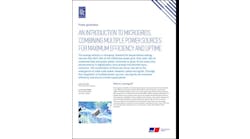Nicole Bulgarino of Ameresco explores the benefits of federal microgrids, and how they have the potential to enhance resiliency for the broader communities surrounding federal facilities.
The federal government has been at the forefront of distributed energy for the last decade, supported by executive orders and Department of Defense (DoD) policies promoting renewables such as solar PV, cogeneration and other distributed energy technologies. Early initiatives focused on reductions in carbon emissions and energy costs for the federal government. The focus in distributed energy today is shifting toward resiliency, and the federal government is looking at ways to coordinate distributed generation assets into organized microgrids that can support operations if the broader utility grid goes down.
The DoD, which represents a significant part of the total energy consumption by the federal government, has been one of the key proponents of microgrids among federal agencies, emphasizing continuity of operations for mission-critical activities. A disruption to energy supply at a DoD installation can lead to any number of negative outcomes for national security – new recruits that don’t get the training they need, ships and aircraft that experience delays in maintenance, among many others. As energy storage and other microgrid-enabling technologies have become more cost effective, the DoD has moved quickly to implement them, along with new and existing distributed energy assets, to sustain their most critical loads and avoid system downtime during major outages.
The interest in microgrids has not been limited to the DoD. The Department of Veterans Affairs (VA) and other Civilian Agencies, for example, have long used diesel generators at their facilities to provide critical backup power during outages; however, given that energy storage can engage more quickly than diesel generators during an outage, these agencies are starting to install microgrids with battery energy storage systems at many of their facilities. Additionally, the Department of Energy is heading up an initiative aimed at making federal facilities more “grid-interactive,” enabling them to participate in utility programs (such as demand response and ancillary services) and integrate renewables, opening up opportunities for microgrids across the entire federal portfolio.
Federal agencies have leveraged power purchase agreements with distributed and renewable energy providers, and included incentives for continuity of energy supply during outages of the incumbent commercial energy provider.
Beyond on-site benefits in terms of energy security and control for the federal government, microgrids are also starting to provide benefits to the neighboring grids in which those federal facilities are located. In many parts of the U.S., the local military installation or government laboratory is the local utility’s largest energy consumer, so a more reliable energy supply at large federal facilities can boost utilities’ ability to manage the system overall. Moreover, the sophisticated gear and control systems that enable a federal microgrid to interconnect with the distribution system and respond to changing grid conditions can also enable greater visibility and dispatch of resources during a major outage. In the coming years, we expect utilities and the federal government to continue to partner on mutually beneficial energy infrastructure that helps the federal government cover its critical loads while also improving the resiliency of the broader grid.
Of course, budget shortfalls remain a perennial feature of the federal government’s efforts to upgrade infrastructure. In the absence of appropriations to support microgrid development, the federal government still has a number of ways to finance microgrids at its disposal. In particular, contract vehicles such as energy savings performance contracts (ESPCs) and utility energy service contracts (UESCs) leverage third-party financing and are repaid through the project’s energy savings. Notably, these mechanisms provide ways to finance microgrids without using new taxpayer funds, and may also include long term sustainment of the systems for two decades or more. Often, standard ESPC and UESC projects can add microgrid-enabling technologies into the overall bundle of self-funding measures by extending the contract performance period. Alternatively, federal agencies have leveraged power purchase agreements with distributed and renewable energy providers, and included incentives for continuity of energy supply during outages of the incumbent commercial energy provider. This method provides for a competitive and creative approach using energy storage technologies or a more conventional redundancy- and alternate-supply approach to resiliency in energy supply.
Today, there are a few military installations and other federal facilities that have what might be considered a “sophisticated” or “comprehensive” microgrid. However, looking forward into the next five years, we anticipate that microgrid-enabled military installations will become more common, and the number of federal microgrids will grow. This will not only help support mission-critical operations for the federal government but will also enhance resiliency for the broader communities surrounding federal facilities.
Nicole Bulgarino is executive vice president at Ameresco.







